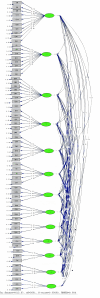Psychometric properties of the Persian version of the training needs assessment for critical care nurses
- PMID: 40775627
- PMCID: PMC12330008
- DOI: 10.1186/s12909-025-07657-y
Psychometric properties of the Persian version of the training needs assessment for critical care nurses
Abstract
Background: Identifying the training needs of critical care nurses is crucial for enhancing their performance and optimizing patient outcomes. This process requires a comprehensive understanding of their specific knowledge gaps and skill deficiencies. Therefore, a reliable and validated tool is necessary to assess these needs effectively.
Aim: This study aimed to assess the psychometric properties of the Persian version of the Training Needs of Critical Care Nurses Scale (TNCCNS) in Iran.
Methods: This cross-sectional methodological study evaluated the Persian version of the TNCCNS using a convenience sample of 676 intensive care unit nurses from hospitals in Kermanshah, Hamadan, and Tabriz. The study was conducted in two phases: translation and cultural adaptation, followed by an assessment of the psychometric properties of the Persian version. Exploratory factor analysis (EFA) and confirmatory factor analysis (CFA) were performed to examine the construct validity of the instrument. Additionally, internal consistency reliability was assessed using Cronbach's alpha and McDonald's omega coefficients, while test-retest reliability was evaluated using the Intraclass Correlation Coefficient (ICC). Data analysis was conducted using SPSS (version 27) and LISREL (version 8). Statistical significance for all analyses was set at p < 0.05.
Results: The results of the EFA and CFA confirmed the thirteen-factor structure with 66 items, explaining 62.337% of the total variance. CFA indicated a good model fit (RMSEA = 0.056, CFI = 0.92, NNFI / TLI = 0.94, GFI = 0.98, SRMR = 0.046, χ²/df = 2.25). Pearson correlation analysis revealed significant positive relationships between each subscale score and the overall scale score. The scale demonstrated high reliability (Cronbach's alpha = 0.912, McDonald's omega = 0.902) and strong stability (ICC = 0.912, 95% CI: 0.900-0.924).
Conclusions: The Persian TNCCNS has demonstrated robust validity and reliability, establishing itself as a valuable tool for assessing the training needs of ICU nurses in Iran. Its validation carries significant implications for both research and practice, offering a robust framework for evaluating the educational requirements of Iranian critical care nurses and the effectiveness of existing training programs. Furthermore, these findings provide essential guidance for educational administrators and policymakers in designing targeted interventions that enhance nursing competencies and improve patient care outcomes in ICU settings.
Clinical trial number: Not applicable.
Keywords: Critical care; Nurse; Psychometry; Reliability; Training needs; Validity.
© 2025. The Author(s).
Conflict of interest statement
Declarations. Ethics approval and consent to participate: This study received ethical approval from the Ethics Committee of Kermanshah University of Medical Sciences (Ethics code: IR.KUMS.REC.1402.342). Written permission to utilize the research scale was obtained from its developer. Prior to participation, all individuals provided written informed consent. The study was conducted in accordance with the ethical principles outlined in the Declaration of Helsinki and adhered to all relevant guidelines and regulations. Consent for publication: Not applicable. Competing interests: The authors declare no competing interests.
Figures
Similar articles
-
Psychometric Evaluation of the Persian Version of the Professional Socialization Scale for Hospital Nurses: A Methodological Study.SAGE Open Nurs. 2025 Jun 19;11:23779608251345276. doi: 10.1177/23779608251345276. eCollection 2025 Jan-Dec. SAGE Open Nurs. 2025. PMID: 40546805 Free PMC article.
-
Adaptation and validation of the Chinese version of the digital addiction scale for children (DASC).BMC Public Health. 2025 Jul 30;25(1):2599. doi: 10.1186/s12889-025-23817-7. BMC Public Health. 2025. PMID: 40739489 Free PMC article.
-
Validity and reliability of the Persian version of the emotional labour scale for nurses.BMC Nurs. 2025 Jul 15;24(1):923. doi: 10.1186/s12912-025-03587-8. BMC Nurs. 2025. PMID: 40665338 Free PMC article.
-
Validity and reliability study of the Turkish version of the autism spectrum knowledge scale.Acta Psychol (Amst). 2025 Aug;258:105204. doi: 10.1016/j.actpsy.2025.105204. Epub 2025 Jun 25. Acta Psychol (Amst). 2025. PMID: 40570585 Review.
-
The measurement of collaboration within healthcare settings: a systematic review of measurement properties of instruments.JBI Database System Rev Implement Rep. 2016 Apr;14(4):138-97. doi: 10.11124/JBISRIR-2016-2159. JBI Database System Rev Implement Rep. 2016. PMID: 27532315
References
-
- Wakefield M, Williams DR, Le Menestrel S. The future of nursing 2020–2030: charting a path to achieve health equity. National Academy of Sciences; 2021. - PubMed
-
- Çatak T. Nursing and environmental sustainability: pioneers of green transformation in health. Sabuncuoglu Serefeddin Health Sci. 2024;6(1):51–62.
-
- Santana-Padilla YG, Santana-Cabrera L, Bernat-Adell M, Linares-Pérez T, Alemán-González J, Acosta-Rodríguez R. Training needs detected by nurses in an intensive care unit: a phenomenological study. Enfermería Intensiva (English Ed). 2019;30(4):181–91. - PubMed
MeSH terms
LinkOut - more resources
Full Text Sources
Miscellaneous



